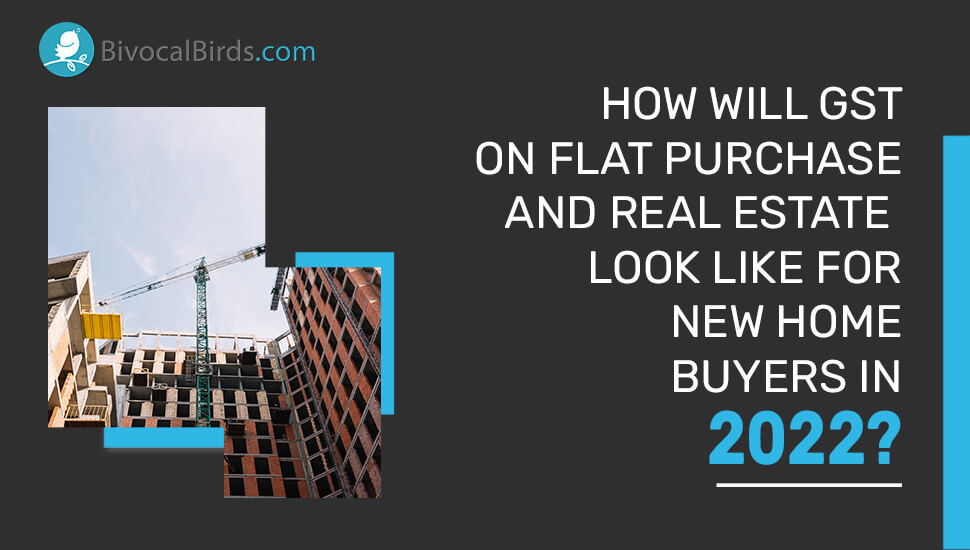How will GST on Flat Purchase and Real Estate Look like for new home buyers in 2022
 13-Apr-2022
13-Apr-2022The Goods and Services Tax, or GST, on flats and apartments is one of the several taxes that buyers must pay when purchasing a home. The ramifications of the GST for real estate in general, and home buyers in particular, are examined in this guide. In addition, we'll talk about the GST rate on flat purchases in 2022 and the GST rate on land purchases in 2022.
Real-estate taxes
In India, home buyers must pay a Goods and Services Tax (GST) of 1% for affordable housing and 5% for non-affordable housing when purchasing under-construction properties such as flats, apartments, and bungalows. The GST is also applicable to the purchase of developable plots in real estate.
GST on the buying of a flat
In 2022, anyone purchasing flats and apartments in under-construction developments in India's megacities would be subject to GST. It's worth noting that the GST on flat purchases does not apply to completed projects. A finished project is one that has acquired a certificate of completion from a competent body.
Prior to the adoption of the GST, there were taxes.
Prior to the implementation of the GST in 2017, a number of state and federal taxes were levied on structures throughout the development of a housing project. While these taxes increased the cost of project development for developers, there was no credit for builders against the output liability for these taxes. Prior to the implementation of the GST, real estate developers had to pay a variety of taxes, including:
VAT stands for Value Added Tax (VAT)
Excise Central
Taxes on entry
LBT
Octroi
Taxes on services, etc.
The cost of these taxes borne by builders was then passed on to the property buyer.
Read More: A Guide to the Property Tax in Delhi 2020-2021: All You Need to Know
Following the adoption of the GST
The GST, which went into effect on July 1, 2017, was hailed as India's biggest tax reform since independence. Multiple indirect taxes were merged into the GST to give taxpayers a more consistent experience. Since its inception, the tax category in which real estate is charged under the GST regime has changed several times.
Types of central and state taxes included as part of the GST.
These are the types of central and state taxes that the GST constituted when it came into force in July 2017:
Central taxes
1. Excise Duty
2. Customs Duty
3. Special Additional Duty of Customs
4. Service Tax
5. Central Sales Tax
6. Central surcharge and cess on supply of goods and services
State taxes
1. State Value Added Tax
2. Entertainment Tax
3. Luxury Tax
4. State Excise Duty
5. State surcharge and cess on supply of goods and services
6. Taxes on advertisement
7. Purchase tax
8. Taxes on lotteries, gambling and betting
In 2022, there will be a GST on real estate.
Since its inception, the government has considerably decreased the GST rate on property purchases in order to replicate demand during a prolonged slump. According to analysts, this might potentially reduce the buyers' pay-out by 4% to 6% on the whole purchase.
Related: Everything you need to Know About Capital Gains Tax which is Capped at 15%
Did you know about the GST?
Under the GST, residential projects containing up to 15% commercial space are classified as residential properties.
On commercial property, the effective GST rate is 12 percent.
On the acquisition of plots, there is no GST to pay.
When you buy a ready-to-move-in flat, you don't have to pay any GST.
Unless the tenant is a business, landlords are exempt from paying GST.
GST on house registration: GST does not cover stamp duty or registration fees; you must still pay these fees when purchasing a home.
GST is charged on services provided by banks as part of a house loan, such as processing fees, legal fees, and so on.
At least a dozen other taxes have been absorbed by the GST.
GST does not apply to ready-to-move-in flats; it only applies to flats that are still under construction.
It's vital to realize that the GST doesn't apply to the real estate industry. The tax rate that applies to a propertyis determined by work contracts. This is why a developer can't charge GST on ready-to-move-in properties. A property is classified as ready-to-move-in following completion and receipt of the occupancy certificate, and it is no longer covered by the work contract. In other words, the GST would be imposed on the sale of under-construction properties that have not yet received their occupancy certificates. It's also worth noting that, under the previous scheme, buyers of ready-to-move properties had to pay service tax as well.
Land transactions are exempt from the GST.
The sale of land does not include the transfer of goods or services, so it is also exempt from the GST on construction services. Because the cost of land is such an important component in determining property values, GST provides a standard abatement of 33 percent of the entire contract value for taxable real estate transactions to be applied to the cost of land.
GST rate for developable land
Buyers of developable plots will be required to pay 18 percent GST as a result of the AAR decision. Prior to the implementation of the GST, the sale of immovable properties was exempt from the application of the value-added tax, and only direct taxes such as stamp duty and registration fees were paid in such transactions.
Conclusion
Experts in the real estate business believe that 2021 will be the 'Year of Recovery,' as demand grew between July and September. If the third wave of coronavirus infection does not halt the recovery process, growth momentum is predicted to stay unchanged in 2022.Looking to rent a flat just visit our website www.bivocalbirds.com
Related Article: Should the property owner pay the security tax



